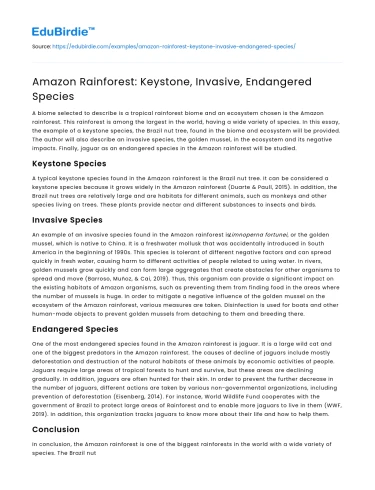A biome selected to describe is a tropical rainforest biome and an ecosystem chosen is the Amazon rainforest. This rainforest is among the largest in the world, having a wide variety of species. In this essay, the example of a keystone species, the Brazil nut tree, found in the biome and ecosystem will be provided. The author will also describe an invasive species, the golden mussel, in the ecosystem and its negative impacts. Finally, jaguar as an endangered species in the Amazon rainforest will be studied.
Keystone Species
A typical keystone species found in the Amazon rainforest is the Brazil nut tree. It can be considered a keystone species because it grows widely in the Amazon rainforest (Duarte & Paull, 2015). In addition, the Brazil nut trees are relatively large and are habitats for different animals, such as monkeys and other species living on trees. These plants provide nectar and different substances to insects and birds.
Save your time!
We can take care of your essay
- Proper editing and formatting
- Free revision, title page, and bibliography
- Flexible prices and money-back guarantee
Invasive Species
An example of an invasive species found in the Amazon rainforest is Limnoperna fortunei, or the golden mussel, which is native to China. It is a freshwater mollusk that was accidentally introduced in South America in the beginning of 1990s. This species is tolerant of different negative factors and can spread quickly in fresh water, causing harm to different activities of people related to using water. In rivers, golden mussels grow quickly and can form large aggregates that create obstacles for other organisms to spread and move (Barroso, Muñoz, & Cai, 2019). Thus, this organism can provide a significant impact on the existing habitats of Amazon organisms, such as preventing them from finding food in the areas where the number of mussels is huge. In order to mitigate a negative influence of the golden mussel on the ecosystem of the Amazon rainforest, various measures are taken. Disinfection is used for boats and other human-made objects to prevent golden mussels from detaching to them and breeding there.
Endangered Species
One of the most endangered species found in the Amazon rainforest is jaguar. It is a large wild cat and one of the biggest predators in the Amazon rainforest. The causes of decline of jaguars include mostly deforestation and destruction of the natural habitats of these animals by economic activities of people. Jaguars require large areas of tropical forests to hunt and survive, but these areas are declining gradually. In addition, jaguars are often hunted for their skin. In order to prevent the further decrease in the number of jaguars, different actions are taken by various non-governmental organizations, including prevention of deforestation (Eisenberg, 2014). For instance, World Wildlife Fund cooperates with the government of Brazil to protect large areas of Rainforest and to enable more jaguars to live in them (WWF, 2019). In addition, this organization tracks jaguars to know more about their life and how to help them.
Conclusion
In conclusion, the Amazon rainforest is one of the biggest rainforests in the world with a wide variety of species. The Brazil nut tree is a common example of a keystone species in this ecosystem. The golden mussel brought from China is an example of an invasive species that can do harm to the native species, and therefore, people intervene to mitigate its negative influence. Finally, jaguar is Amazonian endangered species because of habitat ruining and hunting. To preserve jaguars, it is necessary to reduce deforestation and control hunting.






 Stuck on your essay?
Stuck on your essay?

